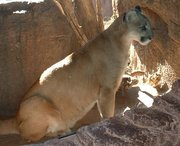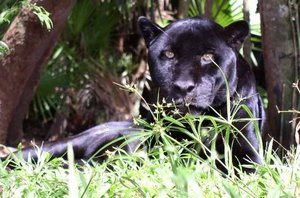Puma
|
|
| Puma | ||||||||||||||
|---|---|---|---|---|---|---|---|---|---|---|---|---|---|---|
| Missing image Puma.jpg Felis concolor | ||||||||||||||
| Scientific classification | ||||||||||||||
| ||||||||||||||
| Binomial name | ||||||||||||||
| Felis concolor (Linnaeus, 1771) |
The puma (Felis concolor) is a type of big cat found in North, Central and South America. It is also known by the regional names of cougar, mountain lion, panther, catamount, and painted cat. The word puma comes from the Quechua language. In the United States, panther by itself refers to a puma, although the term black panther is more commonly associated with the melanistic variants of leopards or jaguars rather than pumas.
Genetically, pumas are more closely related to leopards than to lions. There is a considerable variation in color and size of these animals across their large range of habitats.
| Contents |
Subspecies
The Florida panther is a rare subspecies of puma that lives in the swamps of southern Florida in the United States, especially in the Everglades. There is currently a widespread effort in Florida to try to save the remaining population of the state's native panthers, as their numbers are extremely sparse.
Population and distribution
Before the modern human population explosion in the Americas, the puma ranged across most of the Americas. Even now, it has the largest range of any New World land animal, spanning 110 degrees of latitude, from the southern Yukon Territory (in Canada) to the southern Andes (on both the Chilean and Argentinian sides).
Puma populations of the United States and Canada
Hunted almost to extinction in the United States, the puma has made a dramatic comeback, with an estimated 30,000 individuals in the western United States. In Canada, pumas are found west of the prairies, in Alberta, British Columbia and the southern Yukon.
Pumas are gradually extending their range to the east, following creeks and riverbeds, and have reached Missouri and Michigan. It is anticipated that they will soon expand their range over the entire eastern and southern United States. There are continuing reports of the survival of a remnant population of the Eastern Cougar in New Brunswick, Ontario, and the Gasp預eninsula of Quebec.
Due to urbanization in the urban-wildland interface, pumas often come into contact with people, especially in areas with a large population of deer, their natural prey. They have also begun preying on pets, such as dogs and cats, and livestock, but have rarely turned to people as a source of food.
There are an estimated 4,000 to 6,000 pumas in California and an estimated 4,500 to 5,000 in Colorado.

Physical characteristics
Pumas are tawny-colored with black-tipped ears and tail. The puma can run as fast as 30 mph (50 km/h), jump 20 ft (6 m) from a standing position, vertically leap 8 ft (2.5 m), and often weigh more than 150 pounds (70 kg). Their bite strength is more powerful than that of any domestic dog. Puma claws are retractable and they have four toes. Adult males may be more than eight feet long (nose to tail), and weigh about 150 pounds (70 kg). In exceptional cases males may reach as much as 200 pounds. Adult females can be 7 ft (2 m) long and weigh about 75 pounds (35 kg). Puma kittens have brownish-blackish spots and rings on their tails. Their life span is about a decade in the wild and 25 years or more in captivity.
Pumas that live closest to the equator are the smallest, and increase in size in populations closer to the poles.
Behavior
Pumas normally hunt large mammals, such as deer and elk, but will eat small animals, such as beavers, porcupines or even mice, if the need arises. They hunt alone and ambush their prey, often from behind. They usually kill with a bite at the base of the skull to break the neck of their target. The carcass of the kill is usually then buried or partially covered to protect it for several days, while the puma continues to roam and comes back for nourishment as needed. Adult males tend to claim a 100 mile² (250 km²) stretch for their territory; adult females take 20 to 60 mile² (50 to 150 km²) on average; however their ranges can vary from as much as 370 mile² (1,000 km²) to as little as 10 mile² (25 km²).
A male may breed with several females. Female pumas usually have 3 or 4 kittens in a den in a rocky location. If a male puma invades the territory of another male, he may kill the kittens of resident females so that they will become receptive to mating.
Attacks on humans
Attacks on humans are rare, but do occur — especially as humans encroach on wildlands and impact the availability of the puma's traditional prey. There were around 100 puma attacks on humans in the USA and Canada during the period from 1890 to January 2004, with 16 fatalities; figures for California were 14 attacks and 6 fatalities. Attacks by puma on humans and pets are associated with urban areas situated in the wildland urban intermix such as the Boulder, Colorado area which have encouraged the traditional prey of the puma, the mule deer, to habituate to urban areas and the presence of people and pets. Pumas in such circumstances may come to lose their fear of both people and dogs and come to see them as prey.
On January 8, 2004 a puma killed and partly ate a mountain biker in Whiting Ranch Wilderness Park in Orange County, California; what is assumed to be the same animal attacked another mountain biker in the park the following day, but was fought off by other bikers. A young male puma was shot nearby by rangers later in the day.
Puma safety tips
These safety tips were provided by the California Department of Fish and Game and compiled for the Orange County Register by news researcher M. Doss:
- Do not hike alone; go in groups with adults supervising children.
- If you are confronted by a mountain lion, do not run; that might stimulate a lion's instinct to chase. Instead, stand and face the animal, make eye contact.
- Pick up young children, without bending or turning from the lion if possible.
- Do not crouch down or bend over; you may appear like ordinary four-legged prey to the lion instead of a human.
- Do all you can to appear larger; raise your arms, open your jacket, throw stones, branches.
- Fight back if attacked. Mountain lions have been repelled with rocks, sticks, garden tools, kicks, and bare hands.
- the best place to hit a mountain lion is on the nose.
- Remove dense and low-lying vegetation that provide good hiding places for mountain lions.
- Install motion-sensitive outdoor lighting.
- Keep pets from roaming, and don't feed pets outside.
Jogging and running on wildland trails can be particularly hazardous since such runners are likely to be less attentive to the surroundings and the motion can trigger a "chase and kill" reflex in the animal.
Further reading
- David Baron, Beast in the Garden: A Modern Parable of Man and Nature, W. W. Norton, November, 2003, hardcover, 320 pages, ISBN 0393058077
External links
- Ontario Puma Foundation (http://www.ontariopuma.ca)
- Cat Specialist Group: Puma (Puma concolor) (http://lynx.uio.no/catfolk/puma-01.htm)
- The Mountain Lion aka Cougar and Puma (http://www.mortay.com/Cougar/Lion.shtml)
- Mountain Lion Foundation of Texas (http://www.mountainlions-texas.org/)
- Mountain Lion Foundation of California (http://www.mountainlion.org/)
- Hinterland's Who's Who: Cougar (http://www.hww.ca/hww2.asp?pid=1&id=87&cid=8)
- Mountain Lion Attacks On People in the U.S. and Canada (http://tchester.org/sgm/lists/lion_attacks.html)
- Mountain Lion Attacks (http://users.frii.com/mytymyk/lions/intro.htm)
- Florida Panther Net (http://www.panther.state.fl.us/)
- Southern California Puma Project (http://www.vetmed.ucdavis.edu/whc/scp/mnt_lion.htm)
- Cougars in Canada (http://www.canadiangeographic.ca/Magazine/mj04/indepth/)
- San Diego Zoo "Animal Bytes" (http://www.sandiegozoo.org/animalbytes/t-puma.html) - overview and pictures

